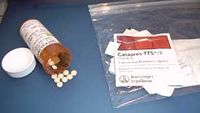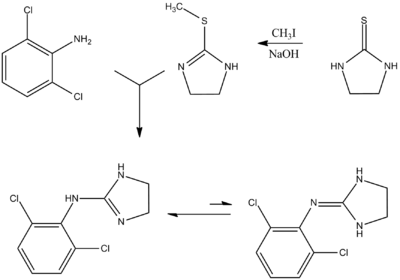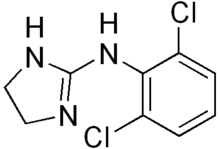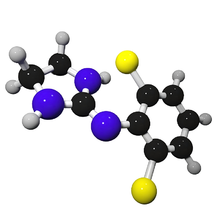Clonidine
Clonidine (Catapres) is a medication used to treat several medical conditions. It is a direct-acting α2 adrenergic agonist.
Uses
It has been prescribed historically as an antihypertensive agent. It has found new uses, including treatment of some types of neuropathic pain, opioid detoxification, sleep hyperhidrosis, anaesthetic use, and off-label, to counter the side effects of stimulant medications such as methylphenidate or amphetamine. It is becoming a more accepted treatment for insomnia, as well as for relief of menopausal symptoms. Clonidine is increasingly used in conjunction with stimulants to treat attention-deficit hyperactivity disorder (ADHD), for which it is administered in late afternoon or evening for sleep, and because it sometimes helps moderate ADHD-associated impulsive and oppositional behavior, and may reduce tics.[1] Clonidine can be used in the treatment of Tourette syndrome.[2] Its epidural use for pain during labor, postoperative and intactable pain has also been studied extensively.[3]
Clonidine is also a mild sedative, and can be used as premedication before surgery or procedures. [4]
Mechanism
Clonidine treats high blood pressure by stimulating α2 receptors in the brain, which decreases cardiac output and peripheral vascular resistance, lowering blood pressure. It has specificity towards the presynaptic α2 receptors in the vasomotor center in the brainstem. This binding decreases presynaptic calcium levels, and inhibits the release of norepinephrine (NE). The net effect is a decrease in sympathetic tone.[5]
Indications & preparations

Clonidine tablets and transdermal patch
Clonidine is typically available as tablets (Catapres, Dixarit), as a transdermal patch (Catapres-TTS), or as an injectable form to be given epidurally, directly to the central nervous system.
FDA approved uses
This medication may also be used to ease withdrawal symptoms associated with the long-term use of narcotics, alcohol and nicotine (smoking). In addition, clonidine has also been used for migraine headaches, hot flashes associated with menopause, and attention deficit hyperactivity disorder.[6][7]
Clonidine is regularly prescribed to opiate addicts to help alleviate their withdrawal symptoms. It is mainly used to combat the sympathetic nervous system response to opiate withdrawal, namely tachycardia and hypertension, in the initial days of withdrawals.[8] It helps take away the sweating, hot/cold flashes, and general restlessness. The sedation effect is also useful although its side effects can include insomnia, thus exacerbating an already common feature of opiate withdrawal.[9]
Off-Label Uses
Clonidine is used off-label to treat psychiatric disorders including stress, sleep disturbances, and hyperarousal caused by post-traumatic stress disorder, borderline personality disorder, and other anxiety disorders. [10] [11] [12] [13] [14] [15] [16] [17] [18]
Clonidine along with Methylphenidate has been studied for treatment of ADHD.[19][20]
An extended-release version of clonidine named Clonicel is also being studied for treatment of ADHD[21][22][23][24].
Adverse effects
This drug may cause lightheadedness, dry mouth, dizziness, or constipation. Clonidine may also cause hypotension[25]
Clonidine also has peripheral alpha agonist effects, which can lead to hypertension. These effects are seen during an overdose in children, where after taking clonidine their blood pressure increases. As the clonidine is eliminated by the body the peripheral effects wear off and the central hypotensive effects become visible. Both the hypertensive and hypotensive effects can be harmful. [26]
Recommended dosage
Dosages of 0.4–0.6 mg have been used for the treatment of alcohol withdrawal. Total daily dosage for the treatment of opiate withdrawal range between 0.5 and 1.4 mg, depending on the stage as well as the severity of withdrawal symptoms. If the clonidine patch is used to treat nicotine withdrawal symptoms, dosages that deliver 0.1–.2 mg daily are used. For oral therapy (tablets), a total dosage of 0.2–0.4 mg daily is taken in divided doses.
Pediatric doses of clonidine are calculated based on the child's body weight. Clonidine dosage for ADHD in children is 5 micrograms per kilogram of body weight per day orally in four divided doses. Children who require a daily dosage of 0.2 mg usually can use the 0.3 mg dermal patch. If ADHD is associated with sleep disturbances, low to moderate doses of clonidine can be taken at bedtime. Oral doses in children with Tourette's syndrome range from 3 to 6 micrograms per kilogram of body weight per day divided into two to four even doses.[27]
Rebound hypertension on withdrawal
Clonidine suppresses sympathetic outflow resulting in lower blood pressure, but sudden discontinuation can cause rebound hypertension due to a rebound in sympathetic outflow.
Clonidine therapy should generally be gradually tapered off when discontinuing therapy to avoid rebound effects from occurring. Treatment of clonidine withdrawal hypertension depends on the severity of the condition. Reintroduction of clonidine for mild cases, alpha and beta blockers for more urgent situations. Beta blockers never should be used alone to treat clonidine withdrawal as alpha vasoconstriction would still continue.[28][29]
Since ADHD drugs like amphetamine and methylphenidate tend to stimulate the sympathetic nervous system, missed doses of clonidine while under ADHD stimulant therapy might entail increased risks of a more severe rebound hypertension. This has not been evaluated.
Pharmacodynamics
Clonidine is a centrally-acting α-adrenergic receptor agonist with more affinity for α2 than α1. It selectively stimulates receptors in the brain that monitor catecholamine levels in the blood. These receptors close a negative feedback loop that begins with descending sympathetic nerves from the brain that control the production of catecholamines (epinephrine, also known as adrenaline, and norepinephrine) in the adrenal medulla. By fooling the brain into believing that catecholamine levels are higher than they really are, clonidine causes the brain to reduce its signals to the adrenal medulla, which in turn lowers catecholamine production and blood levels. The result is a lowered heart rate and blood pressure, with side effects of dry mouth and fatigue. If clonidine is suddenly withdrawn the sympathetic nervous system will revert to producing high levels of epinephrine and norepinephrine, higher even than before treatment, causing rebound hypertension. Rebound hypertension can be avoided by slowly withdrawing treatment.
Clonidine suppression test
Clonidine's effect on reducing circulating epinephrine by a central mechanism was used in the past as an investigatory test for pheochromocytoma,[30] which is a catecholamine-synthesizing tumor, usually of the adrenal medulla. In a clonidine suppression test plasma catecholamines levels are measured before and 3 hours after a 0.3 µg/kg oral test dose has been given to a patient. A positive test occurs if there is no decrease in plasma levels.
Synthesis

Stahle, H.; Koppe, H.; Kummer, W.; Stockhaus, K.; 1976, U.S. Patent 3,937,717.
References
- ↑ National Institute of Neurological Disorders and Stroke (2002). "Methylphenidate and Clonidine Help Children With ADHD and Tics".
- ↑ Schapiro NA. "Dude, you don't have Tourette's": Tourette's syndrome, beyond the tics. Pediatr Nurs. 2002 May-Jun;28(3):243-6, 249-53. PMID 12087644
- ↑ Patel SS, Dunn CJ, Bryson HM (1996). "Epidural clonidine: a review of its pharmacology and efficacy in the management of pain during labour and postoperative and intractable pain". CNS Drugs 6 (6): 474–497.
- ↑ Fazi L. A comparison of oral clonidine and oral midazolam as preanesthetic medications in the pediatric tonsillectomy patient. Anesth Analg. 2001 Jan;92(1):56-61. PMID 11133600
- ↑ Shen, Howard (2008). Illustrated Pharmacology Memory Cards: PharMnemonics. Minireview. pp. 12. ISBN 1-59541-101-1.
- ↑ "Clonidine Oral Uses". Web MD. http://www.webmd.com/drugs/drug-11754-Clonidine.aspx?drugid=11754&drugname=Clonidine.
- ↑ "Clonidine". Drugs.com. http://www.drugs.com/clonidine.html.
- ↑ . AJ Giannini. Drugs of Abuse--Second Edition. Los Angeles, Practice Management Information Corporation,1997.
- ↑ AJ Giannini, I. Extein,MS Gold, ALC Pottash, S. Castellani. Clonidine in mania. Drug Development Research. 3:101-105,1983.
- ↑ PMID 19512980 (PubMed)
Citation will be completed automatically in a few minutes. Jump the queue or expand by hand
- ↑ PMID 18474199 (PubMed)
Citation will be completed automatically in a few minutes. Jump the queue or expand by hand
- ↑ PMID 17506224 (PubMed)
Citation will be completed automatically in a few minutes. Jump the queue or expand by hand
- ↑ PMID 17414682 (PubMed)
Citation will be completed automatically in a few minutes. Jump the queue or expand by hand
- ↑ PMID 17354267 (PubMed)
Citation will be completed automatically in a few minutes. Jump the queue or expand by hand
- ↑ PMID 10560025 (PubMed)
Citation will be completed automatically in a few minutes. Jump the queue or expand by hand
- ↑ PMID 7937367 (PubMed)
Citation will be completed automatically in a few minutes. Jump the queue or expand by hand
- ↑ PMID 2960712 (PubMed)
Citation will be completed automatically in a few minutes. Jump the queue or expand by hand
- ↑ "Understanding Comorbid Depression and Anxiety". http://www.psychiatrictimes.com/anxiety/content/article/10168/53896?verify=0.
- ↑ PMID 18182964 (PubMed)
Citation will be completed automatically in a few minutes. Jump the queue or expand by hand
- ↑ PMID 18182963 (PubMed)
Citation will be completed automatically in a few minutes. Jump the queue or expand by hand
- ↑ "Clinical Trials For Clonicel". http://clinicaltrials.gov/ct2/show/NCT00641329.
- ↑ "Clonicel Press Release". http://www.drugs.com/nda/clonicel_091002.html.
- ↑ "Addrenex's Clonicel Product Data". http://www.addrenex.com/Addrenex-Clonicel-10-01-2009.pdf.
- ↑ PMID 20030423 (PubMed)
Citation will be completed automatically in a few minutes. Jump the queue or expand by hand
- ↑ Hossmann V; Maling TJ, Hamilton CA, Reid JL, Dollery CT. (August 1980). "Sedative and cardiovascular effects of clonidine and nitrazepam". Clin Pharmacol Ther. 28 (2): 167–76. PMID 7398184.
- ↑ "Toxicity, Clonidine". http://emedicine.medscape.com/article/819776-overview.
- ↑ "Clonidine". http://www.minddisorders.com/Br-Del/Clonidine.html.
- ↑ Keith Parker; Laurence Brunton; Goodman, Louis Sanford; Lazo, John S.; Gilman, Alfred (2006). Goodman & Gilman's the pharmacological basis of therapeutics. New York: McGraw-Hill. pp. 854–855. ISBN 0-07-142280-3.
- ↑ Vitiello B (April 2008). "Understanding the risk of using medications for attention deficit hyperactivity disorder with respect to physical growth and cardiovascular function" (PDF). Child Adolesc Psychiatr Clin N Am 17 (2): 459–74, xi. doi:10.1016/j.chc.2007.11.010. PMID 18295156. PMC 2408826. http://www.pubmedcentral.nih.gov/picrender.fcgi?artid=2408826&blobtype=pdf.
- ↑ Eisenhofer G, Goldstein DS, Walther MM, et al. (June 2003). "Biochemical diagnosis of pheochromocytoma: how to distinguish true- from false-positive test results". J. Clin. Endocrinol. Metab. 88 (6): 2656–66. doi:10.1210/jc.2002-030005. PMID 12788870. http://jcem.endojournals.org/cgi/pmidlookup?view=long&pmid=12788870.
External links
|
Sympatholytic (and closely related) antihypertensives (C02) |
|
Sympatholytics
(antagonize α-adrenergic
vasoconstriction) |
|
Central
|
|
α2 agonist
|
Clonidine • Guanfacine • Methyldopa #
|
|
|
Adrenergic release inhibitors
|
Bethanidine • Bretylium • Debrisoquine • Guanadrel • Guanazodine • Guanethidine • Guanoclor • Guanoxan • Guanazodine • Guanoxabenz • Guanoxan
|
|
|
Imidazoline receptor agonist
|
Moxonidine • Rilmenidine
|
|
|
Ganglion-blocking/nicotinic antagonist
|
Mecamylamine • Pentolinium • Trimethaphan
|
|
|
|
Peripheral
|
|
Indirect
|
|
|
Pargyline
|
|
|
Adrenergic uptake inhibitor
|
|
|
|
Tyrosine hydroxylase inhibitor
|
Metirosine
|
|
|
|
Direct
|
|
α1 blockers
|
Prazosin • Indoramin • Trimazosin • Doxazosin • Urapidil
|
|
|
Non-selective α blocker
|
Phentolamine
|
|
|
|
|
| Other antagonists |
|
Serotonin antagonist
|
Ketanserin
|
|
Endothelin antagonist (for PH) |
dual (Bosentan) • selective (Ambrisentan, Sitaxentan)
|
|
|
|
|
|
|
|
anat(a:h,u,t,a,l,v:h,u,t,a,l)/phys/devp/cell/
|
|
proc, drug(C2s/,C3,C4,C5,,C8,C9)
|
|
|
|
|
Antimigraine preparations (N02C) |
|
| Analgesic/abortive |
|
|
|
Ergot alkaloids
|
Dihydroergotamine • Ergotamine • Methysergide • Lisuride
|
|
|
5-HT1 agonists
|
Triptans (Almotriptan, Avitriptan, Eletriptan, Frovatriptan, Naratriptan, Rizatriptan, Sumatriptan, Zolmitriptan) Alniditan
|
|
|
Other
|
Dotarizine
|
|
|
|
Other
|
|
|
|
| Prevention of migraines |
|
|
|
|
|
|
verapamil
|
|
|
corticosteroid
|
flumedroxone
|
|
|
monosaccharide
|
topiramate
|
|
|
adrenergic agonist
|
Clonidine
|
|
|
|
|
|
|
|
|
|
|
| Ungrouped |
piperidine (Pizotifen) • adrenochrome (Iprazochrome) • phenothiazine (Dimetotiazine) • benzoxepin (Oxetorone) • piperazine (Lomerizine) • azepine (Telcagepant)
|
|
|
|
|
|
|
anat(s,m,p,,e,b,d,c,,f,,g)/phys/devp/cell
|
noco(m,d,e,h,v,s)/cong/tumr,sysi/,injr
|
proc,drug(N1A/2AB/C/3/4/7A/B//)
|
|
|
|
|
Ophthalmologicals: antiglaucoma preparations and miotics (S01E) |
|
| Sympathomimetics |
Apraclonidine • Brimonidine • Clonidine • Dipivefrine • Epinephrine |
|
| Parasympathomimetics |
|
muscarinic
|
Aceclidine • Pilocarpine
|
|
|
muscarinic/nicotinic
|
|
|
|
Acetylcholinesterase inhibitors
|
Demecarium • Ecothiopate • Stigmine (Fluostigmine, Neostigmine, Physostigmine) • Paraoxon
|
|
|
Carbonic anhydrase inhibitors/
(sulfonamides) |
Acetazolamide • Brinzolamide • Diclofenamide • Dorzolamide • Methazolamide
|
|
| Beta blocking agents |
Befunolol • Betaxolol • Carteolol • Levobunolol • Metipranolol • Timolol • Mepindolol
|
|
| Prostaglandin analogues (F2α) |
Bimatoprost • Latanoprost • Tafluprost • Travoprost • Unoprostone
|
|
| Other agents |
Dapiprazole • Guanethidine
|
|
|
|
anat(g, a, p)/phys/devp/cell/
|
|
|
|
|
|
|
Antiaddictives (N07B) |
|
Nicotine dependence/
(Nicotinic agonist) |
Nicotine · Dianicline · Varenicline · Lobeline · Mecamylamine · Scopolamine
NDRI ( Bupropion) · AA (Clonidine) · CB1 (Surinabant)
|
|
| Alcohol dependence |
AD inhibitor (Disulfiram, Calcium carbimide) · mGluR (Acamprosate) · Opioid receptor antagonists (Naltrexone, Nalmefene) · Topiramate · AA (Clonidine) · Baclofen
|
|
| Opioid dependence |
|
|
| Stimulant dependence |
|
|
| Benzodiazepine dependence |
|
|
| Cocaine dependence |
|
|
| Sedative-Hypnotic dependence |
|
|
|
|
anat(s,m,p,,e,b,d,c,,f,,g)/phys/devp/cell
|
noco(m,d,e,h,v,s)/cong/tumr,sysi/,injr
|
proc,drug(N1A/2AB/C/3/4/7A/B//)
|
|
|
|
|
Psychostimulants, agents used for ADHD, and nootropics (N06B) |
|
| Centrally acting sympathomimetics |
|
|
| Xanthine derivatives |
|
|
| Glutamate receptor |
|
Racetams
|
Aniracetam • Nefiracetam • Noopept • Oxiracetam • Phenylpiracetam • Piracetam • Pramiracetam
|
|
|
Ampakines
|
CX-516 • CX-546 • CX-614 • CX-691 • CX-717 • IDRA-21 • LY-404,187 • LY-503,430 • PEPA • S-18986 • Sunifiram • Unifiram
|
|
|
| Eugeroics / Benzhydryl compounds |
|
|
| Histamine H3 receptor antagonists |
A-349,821 • ABT-239 • Ciproxifan • GSK-189,254
|
|
| GABAA α5 inverse agonists |
α5IA • L-655,708 • PWZ-029 • Suritozole • TB-21007 • ZK-93426
|
|
| Dopamine D1 receptor agonists |
A-77636 • Dihydrexidine • Dinapsoline • Doxanthrine • SKF-81297 • 6-Br-APB
|
|
| α7 nicotinic agonists / PAMs |
AR-R17779 • PNU-282,987 • SSR-180,711
|
|
| Prolyl endopeptidase inhibitors |
S-17092
|
|
| Alpha-adrenergic agonists |
Clonidine • Guanfacine
|
|
| Other psychostimulants and nootropics |
Acetylcarnitine • Adafenoxate • Bifemelane • Carbenoxolone • Citicoline • Cyprodenate • Ensaculin • Idebenone • Ispronicline • Deanol • Dimebon • Fipexide • Leteprinim • Linopirdine • Meclofenoxate • Nizofenone • P7C3 • Pirisudanol • Pyritinol • Rubidium • Sulbutiamine • Taltirelin • Tricyanoaminopropene • Vinpocetine |
|
|
|
|
dsrd (o, p, m, p, a, d, s), sysi/, spvo
|
|
|
|
|
|
Adrenergics |
|
|
Receptor ligands |
|
|
α1
|
Agonists: 5-FNE • 6-FNE • Amidephrine • Anisodamine • Anisodine • Cirazoline • Dipivefrine • Dopamine • Ephedrine • Epinephrine (Adrenaline) • Etilefrine • Ethylnorepinephrine • Indanidine • Levonordefrin • Metaraminol • Methoxamine • Methyldopa • Midodrine • Naphazoline • Norepinephrine (Noradrenaline) • Octopamine • Oxymetazoline • Phenylephrine • Phenylpropanolamine • Pseudoephedrine • Synephrine • Tetrahydrozoline
Antagonists: Abanoquil • Adimolol • Ajmalicine • Alfuzosin • Amosulalol • Arotinolol • Atiprosin • Benoxathian • Buflomedil • Bunazosin • Carvedilol • CI-926 • Corynanthine • Dapiprazole • DL-017 • Domesticine • Doxazosin • Eugenodilol • Fenspiride • GYKI-12,743 • GYKI-16,084 • Indoramin • Ketanserin • L-765,314 • Labetalol • Mephendioxan • Metazosin • Monatepil • Moxisylyte (Thymoxamine) • Naftopidil • Nantenine • Neldazosin • Nicergoline • Niguldipine • Pelanserin • Phendioxan • Phenoxybenzamine • Phentolamine • Piperoxan • Prazosin • Quinazosin • Ritanserin • RS-97,078 • SGB-1,534 • Silodosin • SL-89.0591 • Spiperone • Talipexole • Tamsulosin • Terazosin • Tibalosin • Tiodazosin • Tipentosin • Tolazoline • Trimazosin • Upidosin • Urapidil • Zolertine
* Note that many TCAs, TeCAs, antipsychotics, ergolines, and some piperazines like buspirone, trazodone, nefazodone, etoperidone, and mepiprazole all antagonize α1-adrenergic receptors as well, which contributes to their side effects such as orthostatic hypotension.
|
|
|
α2
|
Agonists: (R)-3-Nitrobiphenyline • 4-NEMD • 6-FNE • Amitraz • Apraclonidine • Brimonidine • Clonidine • Detomidine • Dexmedetomidine • Dihydroergotamine • Dipivefrine • Dopamine • Ephedrine • Ergotamine • Epinephrine (Adrenaline) • Esproquin • Etilefrine • Ethylnorepinephrine • Guanabenz • Guanfacine • Guanoxabenz • Levonordefrin • Lofexidine • Medetomidine • Methyldopa • Mivazerol • Naphazoline • Norepinephrine (Noradrenaline) • Phenylpropanolamine • Piperoxan • Pseudoephedrine • Rilmenidine • Romifidine • Talipexole • Tetrahydrozoline • Tizanidine • Tolonidine • Urapidil • Xylazine • Xylometazoline
Antagonists: 1-PP • Adimolol • Aptazapine • Atipamezole • BRL-44408 • Buflomedil • Cirazoline • Efaroxan • Esmirtazapine • Fenmetozole • Fluparoxan • GYKI-12,743 • GYKI-16,084 • Idazoxan • Mianserin • Mirtazapine • MK-912 • NAN-190 • Olanzapine • Phentolamine • Phenoxybenzamine • Piperoxan • Piribedil • Rauwolscine • Rotigotine • SB-269,970 • Setiptiline • Spiroxatrine • Sunepitron • Tolazoline • Yohimbine
* Note that many atypical antipsychotics and azapirones like buspirone and gepirone (via metabolite 1-PP) antagonize α2-adrenergic receptors as well.
|
|
|
|
Agonists: 2-FNE • 5-FNE • Amibegron • Arbutamine • Arformoterol • Arotinolol • BAAM • Bambuterol • Befunolol • Bitolterol • Broxaterol • Buphenine • Carbuterol • Cimaterol • Clenbuterol • Denopamine • Deterenol • Dipivefrine • Dobutamine • Dopamine • Dopexamine • Ephedrine • Epinephrine (Adrenaline) • Etafedrine • Etilefrine • Ethylnorepinephrine • Fenoterol • Formoterol • Hexoprenaline • Higenamine • Indacaterol • Isoetarine • Isoprenaline (Isoproterenol) • Isoxsuprine • Labetalol • Levonordefrin • Levosalbutamol • Mabuterol • Methoxyphenamine • Methyldopa • N-Isopropyloctopamine • Norepinephrine (Noradrenaline) • Orciprenaline • Oxyfedrine • Phenylpropanolamine • Pirbuterol • Prenalterol • Ractopamine • Procaterol • Pseudoephedrine • Reproterol • Rimiterol • Ritodrine • Salbutamol (Albuterol) • Salmeterol • Solabegron • Terbutaline • Tretoquinol • Tulobuterol • Xamoterol • Zilpaterol • Zinterol
Antagonists: Acebutolol • Adaprolol • Adimolol • Afurolol • Alprenolol • Alprenoxime • Amosulalol • Ancarolol • Arnolol • Arotinolol • Atenolol • Befunolol • Betaxolol • Bevantolol • Bisoprolol • Bopindolol • Bormetolol • Bornaprolol • Brefonalol • Bucindolol • Bucumolol • Bufetolol • Buftiralol • Bufuralol • Bunitrolol • Bunolol • Bupranolol • Burocrolol • Butaxamine • Butidrine • Butofilolol • Capsinolol • Carazolol • Carpindolol • Carteolol • Carvedilol • Celiprolol • Cetamolol • Cicloprolol • Cinamolol • Cloranolol • Cyanopindolol • Dalbraminol • Dexpropranolol • Diacetolol • Dichloroisoprenaline • Dihydroalprenolol • Dilevalol • Diprafenone • Draquinolol • Dropranolol • Ecastolol • Epanolol • Ericolol • Ersentilide • Esatenolol • Esmolol • Esprolol • Eugenodilol • Exaprolol • Falintolol • Flestolol • Flusoxolol • Hydroxycarteolol • Hydroxytertatolol • ICI-118,551 • Idropranolol • Indenolol • Indopanolol • Iodocyanopindolol • Iprocrolol • Isoxaprolol • Isamoltane • Labetalol • Landiolol • Levobetaxolol • Levobunolol • Levocicloprolol • Levomoprolol • Medroxalol • Mepindolol • Metalol • Metipranolol • Metoprolol • Moprolol • Nadolol • Nadoxolol • Nafetolol • Nebivolol • Neraminol • Nifenalol • Nipradilol • Oberadilol • Oxprenolol • Pacrinolol • Pafenolol • Pamatolol • Pargolol • Parodilol • Penbutolol • Penirolol • PhQA-33 • Pindolol • Pirepolol • Practolol • Primidolol • Procinolol • Pronethalol • Propafenone • Propranolol • Ridazolol • Ronactolol • Soquinolol • Sotalol • Spirendolol • SR 59230A • Sulfinalol • TA-2005 • Talinolol • Tazolol • Teoprolol • Tertatolol • Terthianolol • Tienoxolol • Tilisolol • Timolol • Tiprenolol • Tolamolol • Toliprolol • Tribendilol • Trigevolol • Xibenolol • Xipranolol
|
|
|
|
|
Reuptake inhibitors |
|
|
NET
|
Selective norepinephrine reuptake inhibitors: Amedalin • Atomoxetine (Tomoxetine) • Ciclazindol • Daledalin • Esreboxetine • Lortalamine • Mazindol • Nisoxetine • Reboxetine • Talopram • Talsupram • Tandamine • Viloxazine; Norepinephrine-dopamine reuptake inhibitors: Amineptine • Bupropion (Amfebutamone) • Fencamine • Fencamfamine • Lefetamine • Levophacetoperane • LR-5182 • Manifaxine • Methylphenidate • Nomifensine • O-2172 • Radafaxine; Serotonin-norepinephrine reuptake inhibitors: Bicifadine • Desvenlafaxine • Duloxetine • Eclanamine • Levomilnacipran • Milnacipran • Sibutramine • Venlafaxine; Serotonin-norepinephrine-dopamine reuptake inhibitors: Brasofensine • Diclofensine • DOV-102,677 • DOV-21,947 • DOV-216,303 • JNJ-7925476 • JZ-IV-10 • Methylnaphthidate • Naphyrone • NS-2359 • PRC200-SS • SEP-225,289 • SEP-227,162 • Tesofensine; Tricyclic antidepressants: Amitriptyline • Butriptyline • Cianopramine • Clomipramine • Desipramine • Dosulepin • Doxepin • Imipramine • Lofepramine • Nortriptyline • Protriptyline • Trimipramine; Tetracyclic antidepressants: Amoxapine • Maprotiline • Mianserin • Oxaprotiline • Setiptiline; Others: Cocaine • CP-39,332 • EXP-561 • Fezolamine • Nefazodone • Nefopam • Pridefrine • Tapentadol • Tramadol • Ziprasidone
|
|
|
VMAT
|
|
|
|
|
|
Releasing agents |
|
Morpholines: Fenbutrazate • Morazone • Phendimetrazine • Phenmetrazine; Oxazolines: 4-Methylaminorex • Aminorex • Clominorex • Cyclazodone • Fenozolone • Fluminorex • Pemoline • Thozalinone; Phenethylamines (also amphetamines, cathinones, phentermines, etc): 2-OH-PEA • 4-CAB • 4-FA • 4-FMA • 4-MA • 4-MMA • Alfetamine • Amfecloral • Amfepentorex • Amfepramone • Amphetamine ( Dextroamphetamine, Levoamphetamine) • Amphetaminil • β-Me-PEA • BDB • Benzphetamine • BOH • Buphedrone • Butylone • Cathine • Cathinone • Clobenzorex • Clortermine • D-Deprenyl • Dimethylamphetamine • Dimethylcathinone (Dimethylpropion, metamfepramone) • DMA • DMMA • EBDB • Ephedrine • Ethcathinone • Ethylamphetamine • Ethylone • Famprofazone • Fenethylline • Fenproporex • Flephedrone • Fludorex • Furfenorex • Hordenine • IAP • IMP • L-Deprenyl (Selegiline) • Lisdexamfetamine • Lophophine • MBDB • MDA (Tenamfetamine) • MDEA • MDMA • MDMPEA • MDOH • MDPEA • Mefenorex • Mephedrone • Mephentermine • Methamphetamine ( Dextromethamphetamine, Levomethamphetamine) • Methcathinone • Methedrone • Methylone • NAP • Ortetamine • Paredrine • pBA • pCA • Pentorex (Phenpentermine) • Phenethylamine • Pholedrine • Phenpromethamine • Phentermine • Phenylpropanolamine • pIA • Prenylamine • Propylamphetamine • Pseudoephedrine • Tiflorex • Tyramine • Xylopropamine • Zylofuramine; Piperazines: 2C-B-BZP • BZP • MBZP • mCPP • MDBZP • MeOPP • pFPP; Others: 2-Amino-1,2-dihydronaphthalene • 2-Aminoindane • 2-Aminotetralin • 2-Benzylpiperidine • 4-Benzylpiperidine • 5-IAI • Clofenciclan • Cyclopentamine • Cypenamine • Cyprodenate • Feprosidnine • Gilutensin • Heptaminol • Hexacyclonate • Indanorex • Isometheptene • Methylhexanamine • Octodrine • Phthalimidopropiophenone • Propylhexedrine (Levopropylhexedrine) • Tuaminoheptane
|
|
|
|
Enzyme inhibitors |
|
|
|
|
PAH
|
3,4-Dihydroxystyrene
|
|
|
TH
|
3-Iodotyrosine • Aquayamycin • Bulbocapnine • Metirosine • Oudenone
|
|
|
AAAD
|
Benserazide • Carbidopa • Genistein • Methyldopa
|
|
|
DBH
|
Bupicomide • Disulfiram • Dopastin • Fusaric acid • Nepicastat • Phenopicolinic acid • Tropolone
|
|
|
PNMT
|
CGS-19281A • SKF-64139 • SKF-7698
|
|
|
|
|
|
MAO
|
Nonselective: Benmoxin • Caroxazone • Echinopsidine • Furazolidone • Hydralazine • Indantadol • Iproclozide • Iproniazid • Isocarboxazid • Isoniazid • Linezolid • Mebanazine • Metfendrazine • Nialamide • Octamoxin • Paraxazone • Phenelzine • Pheniprazine • Phenoxypropazine • Pivalylbenzhydrazine • Procarbazine • Safrazine • Tranylcypromine; MAO-A selective: Amiflamine • Bazinaprine • Befloxatone • Befol • Brofaromine • Cimoxatone • Clorgiline • Esuprone • Harmala alkaloids (Harmine, Harmaline, Tetrahydroharmine, Harman, Norharman, etc) • Methylene Blue • Metralindole • Minaprine • Moclobemide • Pirlindole • Sercloremine • Tetrindole • Toloxatone • Tyrima; MAO-B selective: D-Deprenyl • Selegiline (L-Deprenyl) • Ladostigil • Lazabemide • Milacemide • Mofegiline • Pargyline • Rasagiline
* Note that MAO-B inhibitors also influence norepinephrine/epinephrine levels since they inhibit the breakdown of their precursor dopamine.
|
|
|
COMT
|
Entacapone • Tolcapone
|
|
|
|
|
|
Others |
|
|
Precursors
|
|
|
|
|
|
|
|
Others
|
Activity enhancers: BPAP • PPAP; Release blockers: Bethanidine • Bretylium • Guanadrel • Guanazodine • Guanclofine • Guanethidine • Guanoxan; Toxins: Oxidopamine (6-Hydroxydopamine)
|
|
|
|



